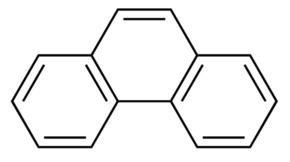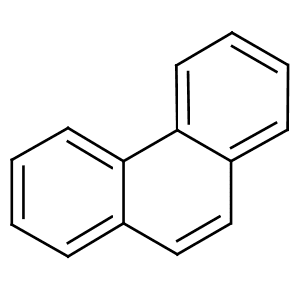Formula C14H10 Density 1.18 g/cm³ Appearance Colorless solid | Boiling point 340 °C | |
 | ||
Dance your phd 2015 dissolution and biodegradation of phenanthrene
Phenanthrene is a polycyclic aromatic hydrocarbon composed of three fused benzene rings. The name 'phenanthrene' is a composite of phenyl and anthracene. In its pure form, it is found in cigarette smoke and is a known irritant, photosensitizing skin to light. Phenanthrene appears as a white powder having blue fluorescence.
Contents
- Dance your phd 2015 dissolution and biodegradation of phenanthrene
- Chemistry
- Canonical forms
- Natural occurrences
- References

The compound with a phenanthrene skeleton and nitrogens at the 4 and 5 positions is known as phenanthroline.
Chemistry

Phenanthrene is nearly insoluble in water but is soluble in most low polarity organic solvents such as toluene, carbon tetrachloride, ether, chloroform, acetic acid and benzene.
The Bardhan–Sengupta phenanthrene synthesis is a classic way to make phenanthrenes.
This process involves electrophilic aromatic substitution using a tethered cyclohexanol group using diphosphorus pentoxide, which closes the central ring onto an existing aromatic ring. Dehydrogenation using selenium converts the other rings into aromatic ones as well. The aromatization of six-membered rings by selenium is not clearly understood, but it does produce H2Se.
Phenanthrene can also be obtained photochemically from certain diarylethenes.
Reactions of phenanthrene typically occur at the 9 and 10 positions, including:
Canonical forms
Phenanthrene is more stable than its linear isomer anthracene. A classic and well established explanation is based on Clar's rule. A novel theory invokes so-called stabilizing hydrogen-hydrogen bonds between the C4 and C5 hydrogen atoms.
Natural occurrences
Ravatite is a natural mineral consisting of phenanthrene. It is found in small amounts among a few coal burning sites. Ravatite represents a small group of organic minerals.
In February 2014, NASA announced a greatly upgraded database for tracking polycyclic aromatic hydrocarbons (PAHs), including phenanthrene, in the universe. According to scientists, more than 20% of the carbon in the universe may be associated with PAHs, possible starting materials for the formation of life. PAHs seem to have begun forming a couple of billion years after the Big Bang, are widespread throughout the universe, and are associated with new stars and exoplanets.
